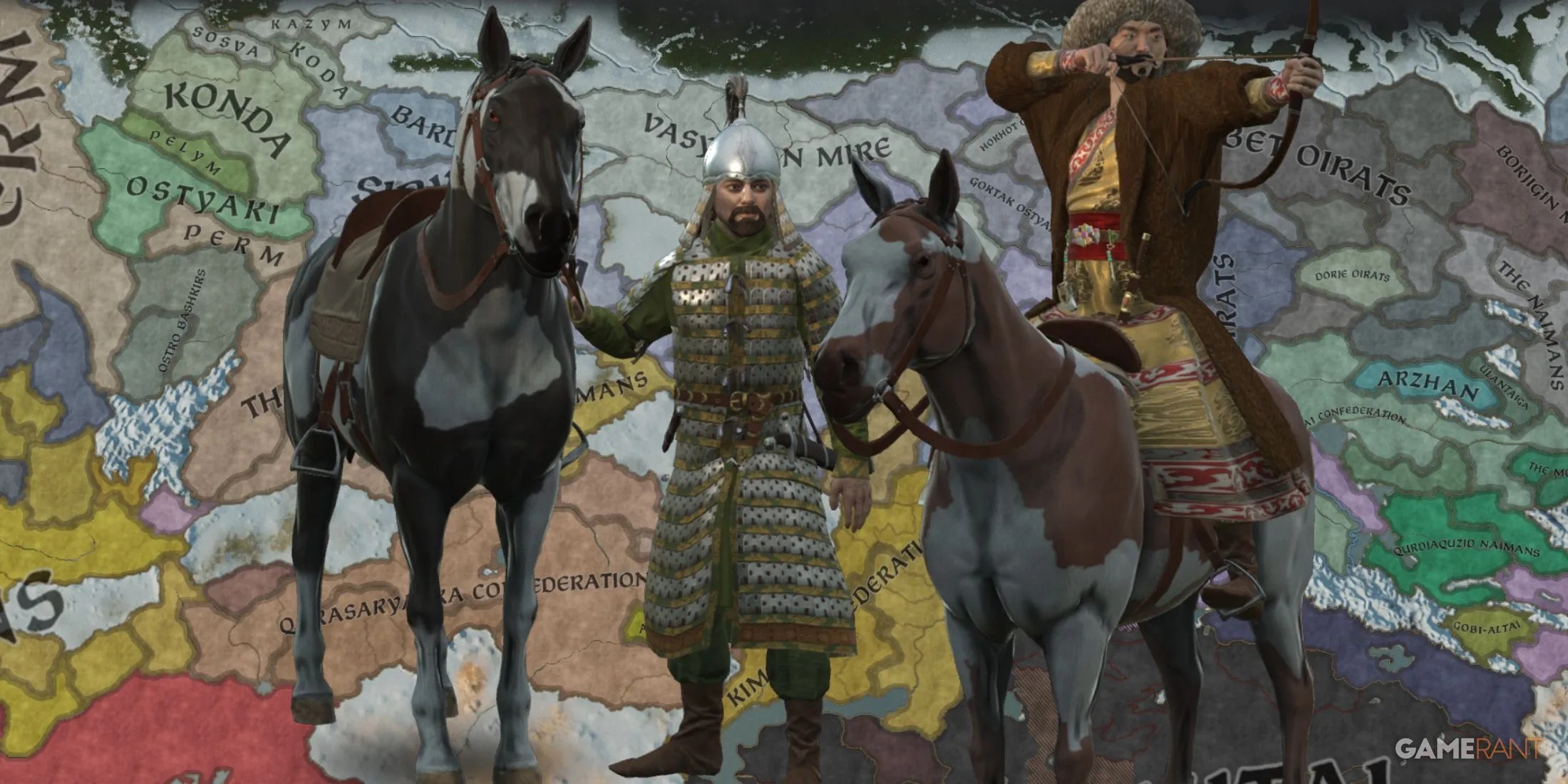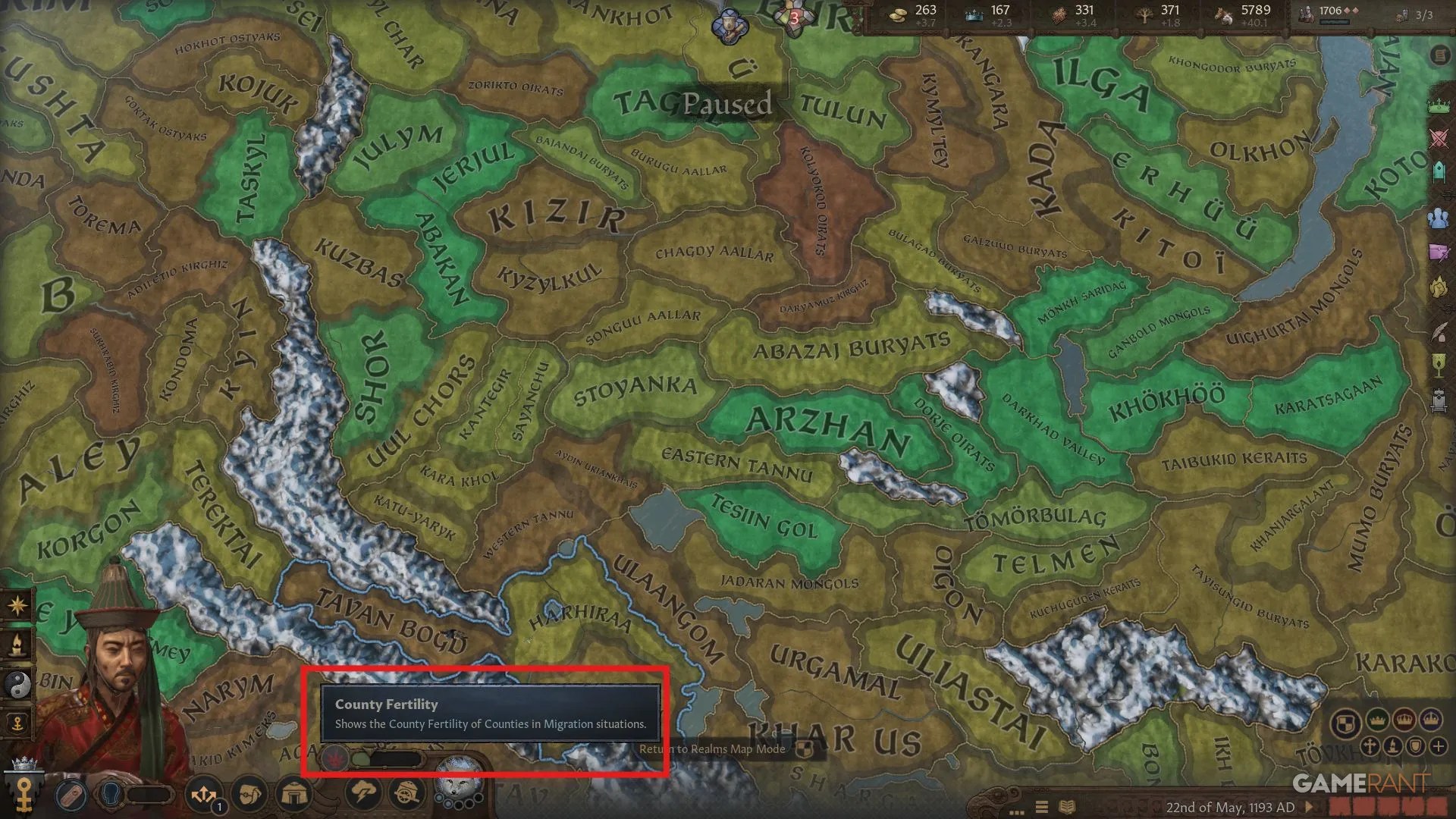Quick Links
Players jumping into theKhans of the SteppeDLC forCrusader Kings 3may find themselves a tad overwhelmed, as Nomads play completely differently from any others on the map. ThisNomad guide forCK3will explain what theHerddoes, how to manageFertility, where and when tomigrate, and, of course, how to conquer the Steppe or other Nomadic regions.
Overview Of Nomads In Crusader Kings 3
Nomads inCrusader Kings 3canonly be played with theKhans of the SteppeDLC, but without it, players can still take control of the same characters, such as the future Genghis Khan, just as Tribals instead. The main difference between Nomads and other Government types inCK3is that theyaren’t tied down to land.
Nomads can be played outside of the Steppe, such as in North Africa, as long as this is turned on in the Game Rules.

It’snot about controlling the most or best land, instead, it’s abouthaving the most powerful Herdand military strength in the region. Due to constant grazing, which results in low fertility, Nomadic rulers will want to migrate, leaving their old home behind. As such, there are no permanent buildings to construct in holdings. Instead, Nomads have a domicile, similar toLandless Adventurers inCK3. For Nomads in the Steppe, these are known as Yurts and can be upgraded, but will always move with the ruler.
If players arestarting out fairly weakas just another Nomad in the vast Steppe, they will want tostart by raiding. When Nomads raid, they cangain Gold and Herd, both of which are vital. With more Herd, their army will be bigger and they will have more bargaining power. WithGold, they canconvert some of their Herd into Men-at-arms, such as Torch Bearers or Mounted Archers. This should enable them to snowball, leading to more raids and some offensive wars.

The Steal Herd scheme is also great to use against neighbors, as it weakens them while you gain more Herd and power.
Players should also look toconvert local Herders into Tributariesbefore another ruler snaps them up. They will usually accept without the need for war, and they will provide around20% of their Herd.

If greater powers are afoot,consider forming a Confederationwith fellow neighbors. This defensive agreement doesn’t have to be permanent, and once players grow in strength, theycan abandon their alliesand even conquer them. Alternatively, by meeting certain requirements, players may be able toturn the Confederation into their own kingdom peacefully.
The Nerge Hunt Activity is another great option, with the chance to gain Gold, Legitimacy, Prestige, and Dread.

The Nomadic Herd In Crusader Kings 3
Herd is a newresource unique to Nomads. It represents a ruler’s people and flock. As aportion of it is converted into Nomadic Hordeused for raiding and war, it also represents power levels. Larger Herds are additionally required toincrease a ruler’s Dominance, which is the Nomadic version of Crown Laws, giving them more power and control.
A ruler with a large Herd but less land is more powerful than a Nomad with lots of land but a small herd.

Herd can also be used tosway charactersor convince them to accept something. It may also be used as aresource for taking Decisions, and lastly, the Herd providessome Goldincome.
Herd can be obtained by:
Certain Cultural Traditions,Dynasty Legacies, Yurt buildings, and higher Legitimacy levels can also increase the rate at which Herd is gained.
Fertility & Seasons In Crusader Kings 3
Nomadic Fertility
Counties located in the Great Steppe and a few other places have County Fertility, representing the quality of its pastures. Withhigh Fertility, Herds can grow, which means rulers become more powerful. Naturally, overtime, the Fertility will decrease.
Thanks to the Fertility Equilibrium, large realms are able to sustain Fertility and their Herd.

This is one of the maincauses of migrationinCK3, as players will need toseek greener lands for their Herd to grow. AI Herders will then move into the vacated land andslowly restore Fertility.
Clicking the Fertility icon in the bottom left willbring up the Fertility map, with bright green representing high Fertility.

Nomadic Seasons
In the Great Steppe and other Nomadic regions on the map, there arelong-lasting Seasons, which can affect Fertility, the Herd, and social tension. Players can click theSeasons buttonin the bottom left to open up a menu on the right.
Assign a competent Stargazer for the most accurate readings of the next Season.

Here, they will be able to see the Season in their current region, theeffects and length of that Season, the chances of thenext Season, and how other regions are faring. If players find themselves with 5 years of a Severe Drought left, it is likelybest to migrate far away. If there’s only a year left and an Everlasting Summer is on the way, consider staying.
As mentioned,Seasons can have social impacts. For example, in the worst Seasons where life becomes tough,a chaotic succession mightensue upon the ruler’s death.

How To Migrate In Crusader Kings 3
When players decide tomigrate inCrusader Kings 3 due to low Fertility, a bad Season, or for better opportunities, they will want to click thewagon button in the bottom left.
This will open up a new view, with players able to toggle the Fertility map on. Byclicking on different regions, players will see on the right if theirMigration can be acceptedby the current occupant. They might be convinced with:

If the specific land you desire won’t be given over freely, or practically no land is available, it is still possible to try migrating. In this case, awar will be waged. For the duration of the war, your people will betemporarily homeless.
Herders are much more likely to accept migration, and their land should be Fertile.
Nomadic Domicile Buildings (Yurts) In Crusader Kings 3
Instead of constructing and upgrading buildings such as castles and cities in holdings, Nomads have aNomadic Capital, which they take with them. This is a Domicile Building, similar to the Camps of Landless Adventurers and Estates ofAdministrative governments inCK3.
The main tent or ‘Yurt’ can be upgraded to improve Herd capacity, Gold and Prestige income, and alsoprovide defensive bonuses. There are other buildings too, which can be chosen from andcustomized with different internal upgrades. This is one of the ways in which Nomads can grow in strength, withupgrades costing Gold, Prestige, and Herd.
Kurultai & Succession
Instead ofstandard Council members inCK3, Nomads appoint Kurultai, who have tasks tied to Nomadic life. For example, they Support Herders or Aid the Stargazer, and Manage Fertility.
Additionally, the Kurultai will play abig role in the realm’s successionwhen a ruler dies. Thus, it is important tokeep them Obedient. Obedience is another new mechanic introduced withKhans of the Steppe, and it is binary, meaning characters areeither Obedient or not.
If all four Kurultai members are Obedient, the ruler’s chosen heir will inherit without any problems. Disobedient Kurultai may attempt to claim the realm for their own or abandon it.
By clicking on a character,Obedience can be negotiatedwith Hooks, Gold, and Herd. Alternatively, withhigh enough Dread, Obedience can bedemanded. Obedient subjects are less likely to rebel or engage in harmful plots.